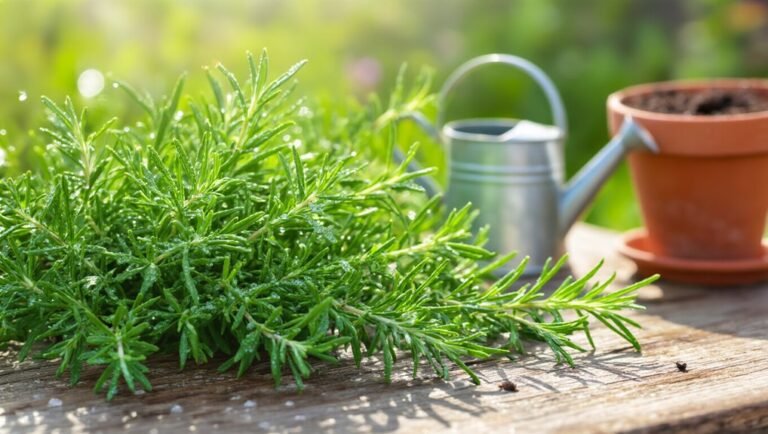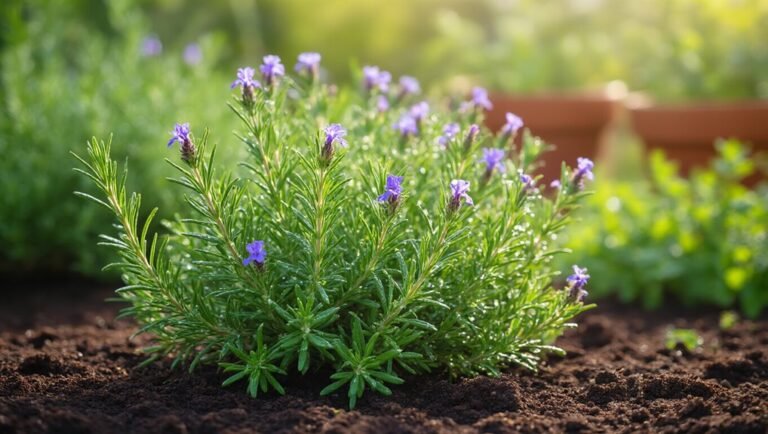To care for rosemary, start with well-draining soil and ensure it gets at least six hours of sunlight daily. Water only when the soil feels dry, and prune regularly to encourage bushier growth. Keep an eye out for pests and use organic treatments if needed. Harvest sprigs carefully to promote healthy growth. Overwinter your plant by bringing it indoors before frost hits. Keep going to discover more essential tips for thriving rosemary plants.
Key Takeaways
- Use a well-draining soil mix with a pH between 6.0 and 7.0 to promote healthy rosemary growth.
- Water rosemary deeply and allow the soil to dry out between waterings to prevent root rot.
- Place rosemary in a location with at least six to eight hours of direct sunlight daily.
- Prune about one-third of the plant in spring to encourage bushier growth and remove dead branches.
- Regularly inspect for pests and diseases, and use organic treatments if necessary to maintain plant health.
Choosing the Right Soil for Rosemary
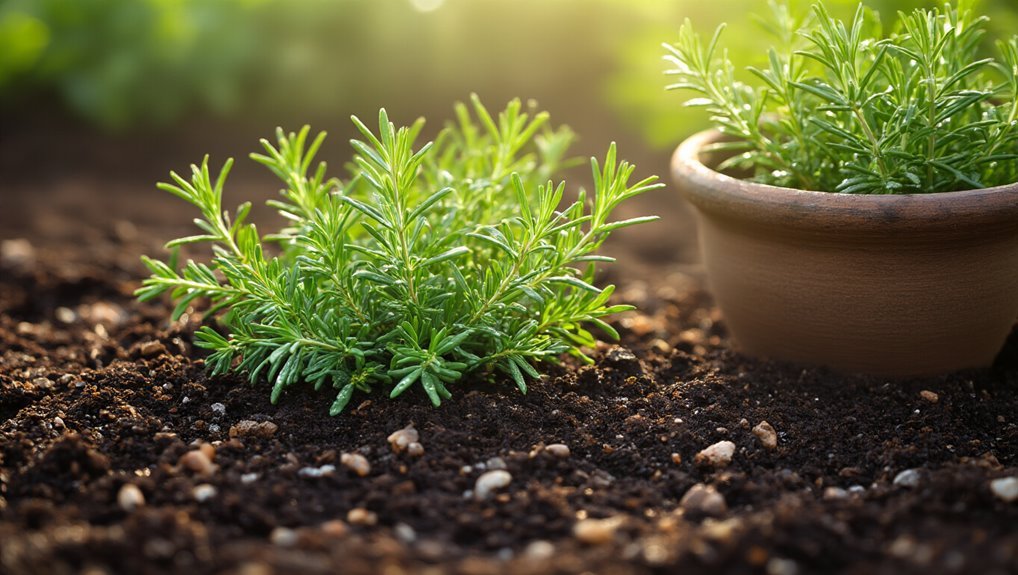
When it comes to choosing the right soil for rosemary, a well-draining mix is essential for healthy growth.
You’ll want to look for a blend that includes coarse materials like sand or perlite, which will prevent water from pooling around the roots. A soil pH between 6.0 and 7.0 works best, so consider testing your soil or using a pre-mixed option designed for herbs. If you want to ensure your soil is free of debris and large particles, consider using a soil sifter or screen before planting to create the ideal texture.
If you’re using potting soil, make sure it’s light and airy; you can even add some grit to improve drainage. Avoid heavy garden soil, as it can retain too much moisture, leading to root rot.
With the right soil, your rosemary will thrive and produce the aromatic leaves you love. For best results, consider starting with garden soil that is specifically formulated to support thriving plants.
Watering Techniques for Healthy Growth
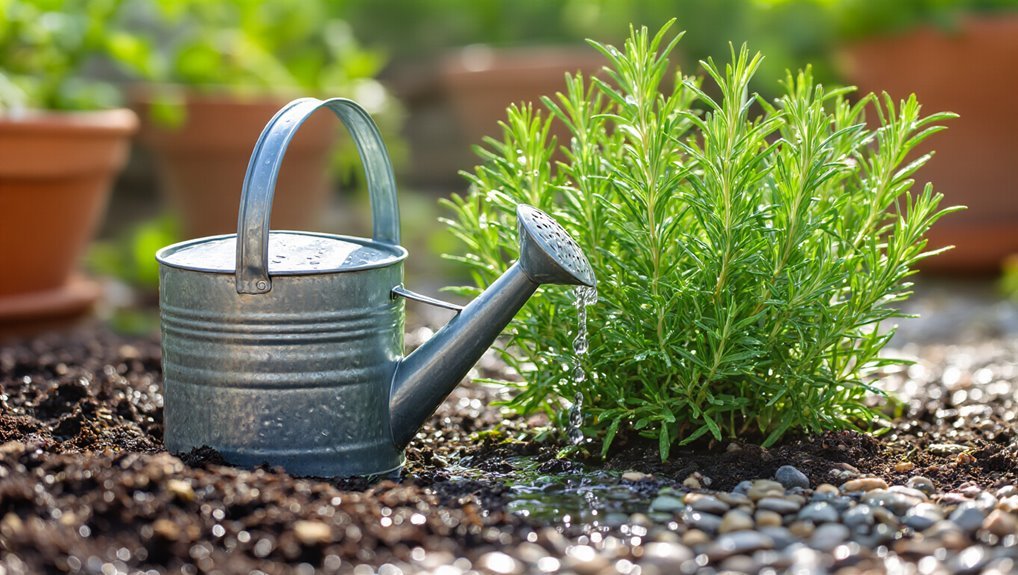
Although rosemary thrives in well-draining soil, proper watering techniques are crucial for keeping your plant healthy. Overwatering can lead to root rot, while underwatering can stress the plant. For gardeners just starting out, using a seed starting kit can help ensure your rosemary seeds germinate in ideal conditions before transplanting outdoors.
Here are some effective watering tips to ensure your rosemary flourishes:
- Check the Soil: Before watering, poke your finger about an inch into the soil. If it feels dry, it’s time to water.
- Water Deeply: When you do water, make sure to soak the soil thoroughly, allowing excess to drain out.
- Frequency: Water less frequently in cooler months; rosemary prefers drier conditions.
- Use Room Temperature Water: Cold water can shock the roots, so let it sit out for a bit before using.
To further support healthy growth, consider supplementing your rosemary with plant fertilizer tablets to provide essential nutrients throughout the growing season.
Ideal Sunlight Conditions

Rosemary needs at least six to eight hours of direct sunlight each day to thrive.
If you’re growing it indoors, place the pot near a south-facing window where it can soak up the sunlight. If outdoors, choose a location that receives ample sunlight throughout the day. Indoor herb gardens make it easy to provide rosemary with the controlled environment it needs for healthy growth all year round.
Keep an eye on its growth; if it starts to stretch or become leggy, it’s a sign it’s not getting enough light. While rosemary can tolerate partial shade, it won’t flourish without sufficient sun exposure.
If your climate permits, consider growing it outside during warmer months, ensuring it’s positioned to catch those sunny rays.
For gardeners looking to optimize their herb cultivation, using raised garden beds can help provide rosemary with excellent drainage and ideal sun exposure.
With the right light, your rosemary will grow lush and flavorful, ready for your culinary creations.
Pruning and Maintenance Practices
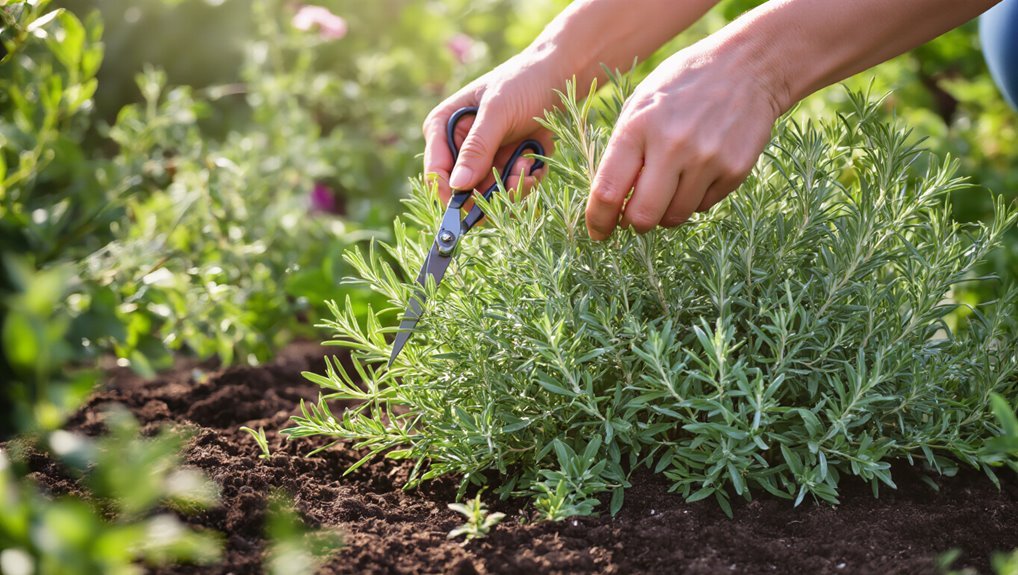
To keep your rosemary thriving, regular pruning and maintenance play a significant role. Pruning encourages bushy growth and reduces the risk of disease. Here are some essential practices to follow:
- Trim regularly: Cut back about one-third of the plant in the spring to promote new growth.
- Remove dead branches: Check for any brown or dried-out stems and remove them to keep the plant healthy. Using essential gardening tool sets can help you efficiently remove dead or unwanted branches, making pruning much easier.
- Shape the plant: Aim for a rounded shape to enhance air circulation and light exposure.
- Water wisely: Ensure the soil dries out between waterings to prevent root rot.
Using the right pruning shears can make these tasks easier and help keep your rosemary plant healthy and well-maintained.
Fertilizing Your Rosemary Plants
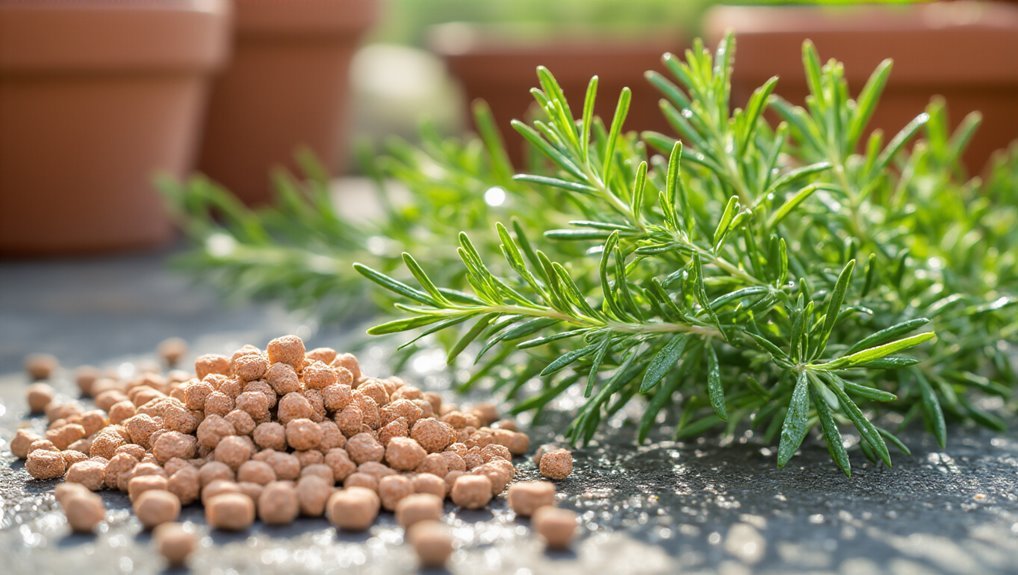
While your rosemary plants can thrive in well-drained soil, proper fertilization is key to ensuring robust growth and flavor.
Start by using a balanced, water-soluble fertilizer, diluted to half strength. Apply it every four to six weeks during the growing season, typically spring and summer. For even and efficient application, consider using a fertilizer spreader to distribute nutrients evenly across your garden.
If your rosemary is growing in poor soil, consider using a slow-release organic fertilizer at the start of the season. This will provide essential nutrients over time without overwhelming the plant.
Be cautious not to over-fertilize, as this can lead to excessive foliage growth and diminished flavor. Always water your plants before applying fertilizer to prevent root burn.
For optimal growth, you can choose from the best plant food options available to ensure your rosemary receives all the nutrients it needs.
With these tips, you’ll enjoy healthy, flavorful rosemary that enhances your culinary creations.
Pest and Disease Management
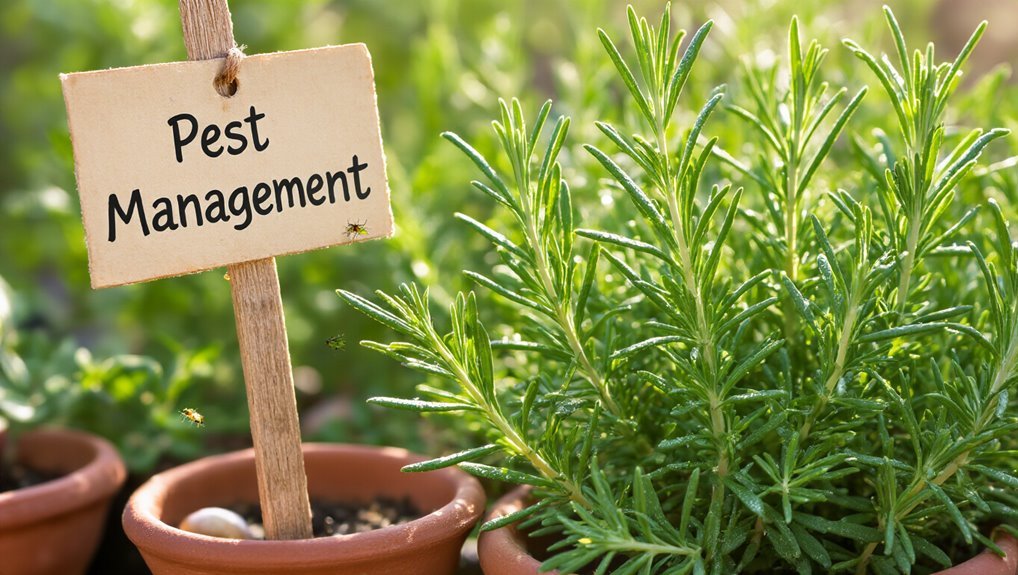
Keeping your rosemary healthy requires vigilance against pests and diseases that can hinder its growth. Here are some essential tips to manage these issues effectively:
- Inspect Regularly: Check your plants for signs of pests like aphids or spider mites. Early detection can save your rosemary.
- Encourage Beneficial Insects: Ladybugs and lacewings help control pest populations naturally. Attract them by planting flowers nearby. You can also add insect repellent plants such as citronella to your garden to further deter unwanted pests.
- Maintain Good Airflow: Space your plants adequately. Proper airflow reduces humidity, which can lead to fungal diseases.
- Use Organic Treatments: If you notice pests, consider neem oil or insecticidal soap. These are effective and safe for your rosemary.
For more persistent problems, you might consider using pest control products that are specifically formulated to target common garden pests while remaining safe for edible herbs.
Harvesting Rosemary for Culinary Use
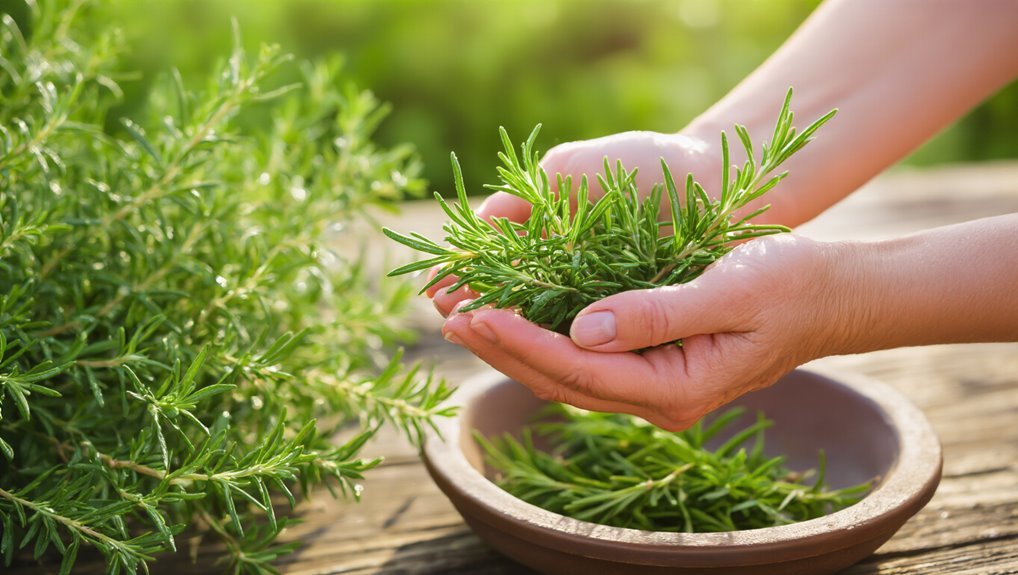
After ensuring your rosemary plants are free from pests and diseases, it’s time to enjoy the rewards of your care by harvesting them for culinary use.
To get the best flavor, pick your rosemary in the morning when the essential oils are at their peak. Use clean, sharp scissors or pruning shears to snip off sprigs, taking care not to remove more than one-third of the plant at a time. This encourages healthy growth. For added protection while working, consider using gardening gloves to keep your hands safe from thorns and irritants.
You can also harvest the tender tips for a milder flavor or the more mature stems for a robust taste. Rinse your sprigs gently under cool water, then shake off excess moisture.
For a more efficient harvest, consider using specialized garden harvesting tools designed for herbs and small plants.
Now you’re ready to add fresh rosemary to your favorite dishes!
Overwintering Rosemary Successfully
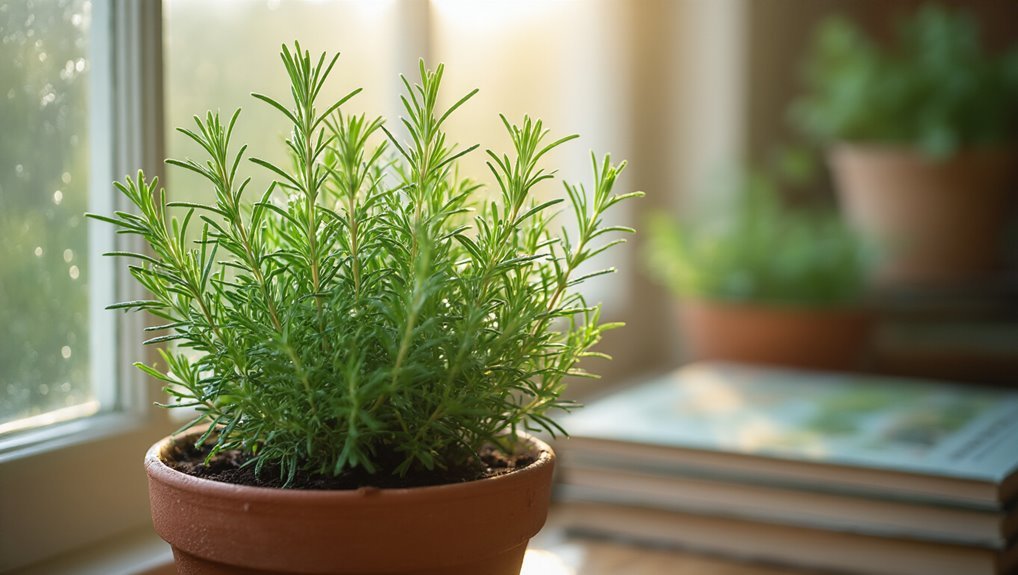
As winter approaches, protecting your rosemary plants becomes essential for their survival. To ensure your rosemary thrives through the cold months, follow these simple steps:
- Bring Indoors: If you’re growing rosemary in pots, move them inside before the first frost. Choose a bright, sunny spot. For gardeners who also store seeds for next season, investing in Garden Seed Storage Containers will help keep seeds organized and protected from moisture while you tend to your indoor herbs.
- Cut Back: Trim your rosemary plants to remove any dead or damaged branches, promoting healthier growth.
- Water Wisely: Reduce watering, as rosemary prefers drier conditions in winter. Allow the soil to dry out between waterings.
- Maintain Humidity: If your home is dry, consider placing a humidifier nearby or misting the leaves occasionally to keep humidity levels up.
Additionally, using compost bins can provide nutrient-rich soil for your rosemary, helping it stay healthy year-round.
Frequently Asked Questions
Can Rosemary Be Grown Indoors Successfully?
Yes, you can grow rosemary indoors successfully! Ensure it gets plenty of sunlight, well-draining soil, and moderate watering. With the right conditions, you’ll enjoy fresh rosemary right from your kitchen. Happy gardening!
What Are Common Varieties of Rosemary for Beginners?
When you think of rosemary, you might picture the popular ‘Tuscan Blue,’ known for its vibrant color and robust flavor. For beginners, this variety’s hardiness and versatility make it an excellent choice for indoor gardening.
How Long Does Rosemary Take to Mature?
Rosemary typically takes about 3 to 4 months to mature, depending on factors like growing conditions and care. With the right attention, you’ll soon enjoy fresh, aromatic leaves ready for your culinary adventures.
Can Rosemary Survive Extreme Temperatures?
Yes, rosemary can survive extreme temperatures, but it thrives best in mild conditions. If you live in an area with harsh winters or scorching summers, consider providing some protection to help it flourish.
Is Rosemary Safe for Pets and Children?
You might think rosemary’s a wild, untamed herb, but it’s actually safe for pets and children in moderation. Just keep an eye on curious noses and tiny hands, and you’ll be just fine!
Conclusion
With the right care, your rosemary can thrive like a fine wine in a rustic cellar. Remember to give it well-draining soil, the right amount of water, and plenty of sunlight. Regular pruning keeps it healthy, while proper fertilization boosts growth. Keep an eye out for pests and diseases, and don’t hesitate to harvest for your favorite recipes. By following these tips, you’ll enjoy a flourishing rosemary plant that’s a joy to have around!
